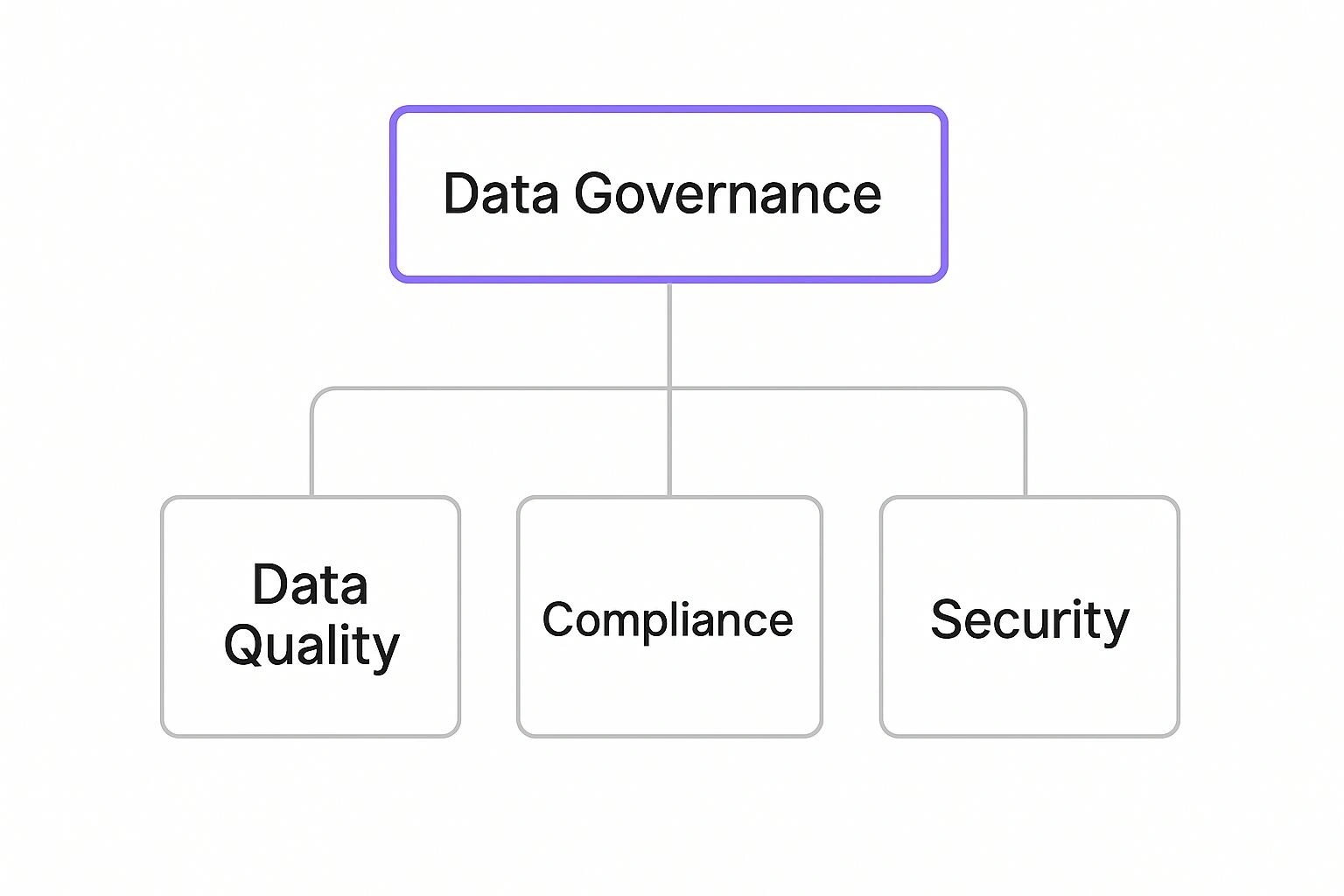What Is Data Governance?
Discover what is data governance and why it’s a business essential. Learn to build a framework that drives growth, ensures compliance, and protects your data.

Let’s be honest, the term “data governance” can sound a bit dry, even intimidating. It often conjures up images of complex rulebooks and restrictive IT policies. But if you strip away the jargon, it’s really about one simple thing: making sure your company’s data is trustworthy, secure, and actually useful.
Think of it as the strategic blueprint for your organisation’s most valuable asset – data. It’s the collection of roles, rules, and processes that turns raw information into a reliable resource for decision-making.
What Is Data Governance, Really?

Data governance is about bringing order to the chaos.
Imagine a sprawling library with no catalogue system. Books are shelved randomly, multiple copies of the same text have different edits, and there’s no librarian to ask for help. Finding the right information would be a nightmare, and you could never be sure if what you found was the correct version.
Data governance is the librarian and the catalogue system for your company’s data. It establishes the rules of the road—the policies, standards, and controls—that ensure data is managed consistently and effectively across every single department.
Fundamentally, data governance is about enabling people in your organisation to use data more effectively. It helps them understand the data they have, assess its quality, and take the necessary actions to improve that quality if needed.
Without this structure, businesses inevitably fall into “data chaos.” The sales team reports one set of figures, finance has another, and marketing is working off an outdated customer list. This disorganisation doesn’t just slow things down; it creates serious compliance risks and undermines confidence in every report and dashboard.
Data Governance vs. Data Management: What’s The Difference?
People often use “data governance” and “data management” interchangeably, but they’re two distinct sides of the same coin. They’re related, but they play very different roles.
Think of it in terms of building a house:
- Governance is the architect who designs the blueprints, ensures the plans meet building codes, and defines the quality standards for materials.
- Management is the construction crew that physically lays the foundation, frames the walls, and installs the plumbing according to those blueprints.
You need both to succeed. A great blueprint is useless without a skilled team to build it, and a skilled team can’t work effectively without a clear plan. Governance provides the strategy; management handles the execution. This relationship ensures everyone knows their role in keeping the company’s data a reliable asset.
Why It’s A Business-Wide Responsibility
Data governance isn’t just an IT problem to solve; it’s a discipline that needs to be woven into the fabric of the entire business. When done right, it empowers everyone—from marketing and sales to finance and operations—to make smarter, faster decisions based on data they can actually trust.
A solid governance program brings much-needed clarity to data ownership, sets clear quality standards, and puts safeguards around sensitive information. For any Australian business looking to compete, establishing a robust governance framework is the essential first step in turning data from a messy operational byproduct into a powerful engine for growth.
The Pillars Of A Modern Data Governance Framework
A solid data governance strategy isn’t a single, monolithic policy. It’s more like a structure built on several essential, interconnected pillars that work together to manage your organisation’s data assets effectively. Getting to grips with these components is the first step toward building a program that actually delivers business value.
Each pillar tackles a specific aspect of data management, from accountability and quality to security and context. By breaking the framework down this way, you can systematically address weaknesses and build a comprehensive governance structure. This approach moves beyond abstract rules to create a practical, working system for data excellence.
This diagram shows how data quality, compliance, and security are fundamental, interconnected outcomes of a strong data governance program.

As you can see, governance is the overarching strategy that makes these critical data objectives achievable. Let’s explore the key pillars that make it all possible.
Data Stewardship: The Human Element
At the very heart of any successful governance program is data stewardship. This is all about accountability and ownership. It answers a simple but vital question: “Who is responsible for this data?”
Stewards aren’t necessarily IT staff. In fact, they’re usually subject matter experts from the business who genuinely understand the data’s context, meaning, and importance. Think of a steward in the finance department—they are responsible for the accuracy and integrity of financial reports. They define what a “valid transaction” is and ensure that all data entering their systems meets that standard. Their job is to be the primary caretaker for a specific data domain.
Data stewardship bridges the gap between technical data management and business goals, ensuring that the people who know the data best are the ones making decisions about it.
Data Quality: Ensuring Trustworthy Information
The second pillar is data quality. If data is the lifeblood of an organisation, its quality determines its health. This component focuses on establishing and maintaining the accuracy, completeness, consistency, and timeliness of data across all your systems.
Poor data quality has real consequences. A marketing team with an inaccurate customer database will waste its budget targeting the wrong people. Incomplete product data can lead to serious supply chain disruptions. The goal is simple: make data fit for its intended purpose.
Key activities here include:
- Data Profiling: Analysing data to understand its current state and pinpoint quality issues.
- Data Cleansing: Correcting or removing inaccurate, incomplete, or inconsistent data.
- Establishing Quality Rules: Defining clear standards and metrics for what “good” data looks like in your organisation.
Effective data quality management isn’t a one-off project; it’s an ongoing discipline. You can explore the processes that create reliable data in our guide on data quality management.
Data Security: Protecting Your Most Valuable Asset
Data security is a non-negotiable pillar of modern data governance. It’s all about protecting data from unauthorised access, use, disclosure, or destruction by implementing the right mix of policies, processes, and technology. This pillar determines who can access what data and under which conditions.
Strong governance depends on robust data security, highlighting the value of hiring a data-driven cybersecurity professional. These experts help implement critical security measures like access controls, encryption, and data masking to protect against both internal and external threats. For example, in a healthcare setting, data governance policies would strictly limit access to patient records, ensuring only authorised medical staff can view them and maintaining compliance with privacy regulations.
Metadata Management: Understanding Your Data’s DNA
The final pillar is metadata management. Often described as “data about data,” metadata provides the essential context that makes your information understandable and useful. It answers questions like: Where did this data come from? What does this term mean? When was it last updated?
Imagine a marketing team receives a spreadsheet of customer leads. Without metadata, they’re flying blind. They wouldn’t know the source of the leads, the date they were collected, or if they have consent for contact. Metadata provides this crucial backstory, turning a simple list of names into a truly actionable asset.
By managing metadata effectively, organisations create a searchable, understandable data catalogue that promotes trust and makes discovery much easier.
A clear definition of roles is critical for a successful data governance program. This table outlines the key roles, their primary responsibilities, and how they interact.
Key Roles And Responsibilities In Data Governance
| Role | Primary Responsibility | Typical Department |
|---|---|---|
| Data Owner | Ultimately accountable for a specific data domain (e.g., customer data). Sets policies and approves access. | Executive Leadership (e.g., CMO, CFO) |
| Data Steward | Manages data quality, definitions, and business rules for a data domain. Ensures data is fit for purpose. | Business Units (e.g., Finance, Marketing) |
| Data Custodian | Implements and manages technical controls for data storage, transport, and security. | Information Technology (IT) |
| Data User | Anyone in the organisation who accesses and uses data as part of their daily job. | All Departments |
Having these roles clearly defined prevents confusion and ensures that every aspect of the data lifecycle, from creation to archival, is properly managed.
Why Data Governance Is A Business Imperative

It’s easy to think of data governance as a technical problem for the IT department to solve. But that’s a dangerously narrow view. At its heart, effective data governance is all about driving business outcomes—sharpening strategy, boosting efficiency, and building a real competitive edge.
Seeing governance as just another cost centre or a compliance checkbox is where many organisations go wrong. Think of it instead as the bedrock for everything you want to achieve with your data. Done right, governance elevates data from a messy operational side-effect into a core strategic asset. This is the mindset that separates data-driven leaders from the laggards.
Sharpening Strategic Decision-Making
Ultimately, data governance is about one thing: trust. Can your leaders confidently stand behind the numbers they’re using to make multi-million dollar decisions? A solid governance framework ensures the data flowing into your board reports and financial forecasts is accurate, consistent, and completely reliable.
Picture a retail executive trying to decide which product lines to expand. Without governance, they might be looking at sales data that doesn’t align with inventory records or marketing spend. That leads to flawed conclusions and wasted investment. With governance, everyone is working from the same playbook—a single source of truth. This allows for confident, data-backed decisions that put resources where they’ll have the most impact.
When that level of trust is established, leaders can stop reacting to problems and start proactively shaping the future. They can spot market trends earlier and anticipate customer needs with far more precision than competitors still stuck arguing over whose spreadsheet is correct.
Good data governance ensures strategic discussions are based on facts, not guesswork. It replaces “I think” with “I know,” fundamentally changing the quality and speed of executive decision-making.
Boosting Operational Efficiency
Bad data is a silent killer of productivity. When different teams are using conflicting or out-of-date information, everything slows down. Employees burn precious hours trying to reconcile reports and hunt for reliable numbers instead of focusing on the work they were hired to do.
Data governance gets right to the root of this issue. By creating clear definitions, standards, and ownership for key data, it smooths out the friction in your daily workflows. The result is less manual correction and far less costly rework.
Think about a manufacturing business where the supply chain, production, and sales teams all use slightly different codes for the same item. It sounds minor, but this simple disconnect can cascade into incorrect orders, production delays, and bloated inventory costs. A governance program would enforce a single, standardised set of codes, creating a seamless flow of information that drives efficiency from the factory floor to the customer’s door.
Unlocking Innovation and Growth
Real innovation is fuelled by high-quality data. To develop new products, create truly personalised customer experiences, or explore new business models, your teams need access to data they can depend on. Governance creates the safe, structured, and reliable environment where this kind of creative work can flourish.
When data is properly managed, your people can confidently dive into advanced analytics and AI projects. They know where the data came from, what it means, and that its use complies with all privacy regulations. This assurance dismantles major roadblocks to innovation.
Take a marketing team looking to build a recommendation engine. They need a clean, 360-degree view of customer behaviour to make it work. Governance provides this by ensuring data from every touchpoint—website visits, purchases, support calls—is integrated and trustworthy. Armed with that solid foundation, they can build powerful models that not only enhance the customer experience but also create entirely new revenue streams.
Navigating The Australian Regulatory Landscape
For any organisation operating in Australia, data governance is more than just a set of internal rules. It’s fundamentally shaped by a complex and ever-evolving legal environment. Think of it this way: good governance isn’t just about making your business run smoother; it’s your primary defence for meeting legal duties, keeping the public’s trust, and steering clear of hefty financial penalties.
Compliance isn’t a box-ticking exercise. It’s woven into the very fabric of how you handle personal information in this country. The law lays down firm expectations for managing, protecting, and using the data you collect. Getting it wrong poses a direct threat to both your bottom line and your brand’s reputation.
The Privacy Act And The Australian Privacy Principles
At the heart of Australia’s data protection laws sits the Privacy Act 1988. This is the key piece of legislation that dictates how most federal government agencies and private organisations with an annual turnover of more than $3 million must handle personal information. The core of the Act is the Australian Privacy Principles (APPs)—a set of 13 legally binding rules that govern the entire lifecycle of personal data.
These principles aren’t just polite suggestions. They are enforceable rules covering everything from transparently managing information and keeping it secure, to giving people access to their own data. They demand a proactive, not reactive, approach to data management.
For instance, APP 1 insists that you have a clearly written and current privacy policy. A little further down, APP 11 requires you to take reasonable steps to protect personal information from being misused, lost, or accessed without permission. The only realistic way to make sure these principles are consistently followed across your entire organisation is with a solid data governance framework.
Increased Powers And New Requirements
The regulatory landscape isn’t standing still. Recent changes to the Privacy Act have significantly ramped up the stakes, introducing stronger enforcement powers for the Office of the Australian Information Commissioner (OAIC) and much tougher penalties for breaches. There’s also a growing focus on accountability, particularly with the rise of automated decision-making. Organisations now have to be much more transparent about how their algorithms impact individuals, which demands clear documentation and justification. For a deeper dive into these shifts, the 2025 Data Governance Trends & Insights Report offers a detailed analysis.
This heightened scrutiny means a “wait and see” attitude to compliance is no longer an option. The push for greater transparency requires governance structures that can meticulously document and explain data-driven decisions at a moment’s notice.
An effective data governance program acts as your compliance backbone. It provides the documented policies, clear accountability, and auditable processes needed to demonstrate due diligence to regulators and build trust with customers.
Without this framework, proving you’ve done the right thing becomes a scramble for paperwork after a crisis hits. With it, compliance becomes a natural by-product of well-managed data.
Governance As Your Compliance Shield
Ultimately, successfully navigating Australia’s regulatory maze comes down to one thing: making compliance operational through governance. It’s about building a system where your legal obligations aren’t just abstract concepts, but are embedded into everyday workflows and technologies.
In practice, this involves several key actions:
- Data Classification: This means identifying and tagging personal and sensitive information so it gets the high level of protection the law demands.
- Access Controls: You need to implement strict rules defining who can see, change, or share specific data sets, which directly addresses principles like APP 11.
- Data Retention Policies: This involves setting clear schedules for how long data is stored and when it must be securely disposed of, aligning with data minimisation.
- Breach Response Plans: You must have a clear, rehearsed plan for what to do if a data breach occurs, a core requirement of the Notifiable Data Breaches (NDB) scheme.
By building these elements into a formal governance program, your organisation stops simply knowing the rules and starts actively living them. This proactive posture is the most effective way to manage risk and prove accountability in an era of intense regulatory oversight.
How To Implement A Data Governance Strategy

Moving from theory to practice with data governance can feel like a massive undertaking. The biggest mistake organisations make is trying to fix everything at once—a “boil the ocean” approach that’s doomed to fail. A far smarter strategy is to start small, deliver real value quickly, and use that success to build momentum.
Think of it like building a house. You wouldn’t try to put up all four walls at the same time. You start by laying a solid foundation, one brick at a time. This phased, iterative process keeps things manageable and ensures your governance program is grounded in genuine business needs right from the get-go.
Secure Executive Buy-In
Before you write a single policy or evaluate any software, your first job is to get genuine backing from the top. This is more than just a signature on a budget request. You need a senior champion who sees data governance for what it is: a core business initiative, not just another IT project.
This executive sponsor will be your advocate in high-level meetings, helping to communicate the program’s value and clear away any political roadblocks. Without that support, even the most well-designed governance plan will be viewed as an optional extra and will likely stall.
Assemble The Governance Council
With an executive sponsor on board, your next move is to build a cross-functional data governance council. This is your command centre, bringing together leaders from key departments like finance, marketing, operations, and IT. Their job is to steer the entire program, making sure it stays aligned with the organisation’s bigger goals.
This council isn’t just for show. It’s an active, decision-making body with clear responsibilities:
- Prioritising Initiatives: They decide which data domains—like customer or product data—need attention first.
- Approving Policies: They give the final sign-off on the data standards and rules created by your data stewards.
- Resolving Disputes: When disagreements over data definitions or access pop up, they’re the final authority.
This collaborative model breaks down the departmental silos that so often lead to data chaos, ensuring decisions are made for the good of the entire business.
Start With A Pilot Project
Forget about a big-bang, company-wide rollout. The best way to begin is with a focused pilot project. Find a specific, high-visibility problem that’s causing real pain for the business. Maybe it’s inaccurate customer contact details that are crippling your sales team’s outreach. Your goal is to solve that one problem and prove the value of governance.
A successful pilot project is your most powerful selling tool. It delivers a tangible win that you can showcase to justify more investment and get the rest of the business excited about what’s next.
During this pilot, you’ll audit the relevant data, define what “good” looks like with clear quality metrics, and appoint data stewards to take ownership. To get it right, it helps to lean on proven data governance best practices to guide your first steps. This targeted approach delivers measurable results and makes the whole process feel much less overwhelming.
Define Policies And Select Tools
Once your pilot project has proven its worth, you can use those learnings to start formalising your data policies and standards. Keep these rules simple, clear, and directly linked to business outcomes. Now is also the time to look at the tools that can support your program, whether it’s a data catalogue, a quality monitoring platform, or a master data management solution.
The key here is to let your policies drive the technology choice, not the other way around. Once you know exactly what you need your processes to achieve, you can find the right tools for the job. This often involves pulling together different data sources, where a solid grasp of master data integration best practices is invaluable. By following this structured path, you can build a sustainable governance program that delivers lasting value.
The Future Of Data Governance In Australia
Data governance isn’t a static, set-and-forget discipline. It’s constantly evolving, responding to new technologies and shifting business priorities. Looking at the horizon, a few powerful trends are already reshaping how Australian organisations will manage and value their data.
Perhaps the biggest driver of change is the rise of artificial intelligence and machine learning. These technologies present a classic double-edged sword for governance. On one hand, they need huge volumes of high-quality, well-governed data to work properly. On the other, their complexity makes traditional oversight a real challenge, pushing concepts like data ethics and responsible innovation from the sideline to centre stage.
Emerging Governance Models
As businesses become more data-savvy, the old-school, centralised governance frameworks are starting to feel restrictive. The future is pointing towards more agile and distributed models that empower people across the business without sacrificing control.
We’re seeing a few key trends take hold:
- Data Democratisation: This is all about giving more employees safe access to data and the tools to make sense of it, finally breaking down those stubborn information silos.
- Data Mesh Architecture: A decentralised approach that hands data ownership and management to domain-specific teams, which massively boosts agility and scale.
- Augmented Governance: This involves using AI-powered tools to automate the grunt work of governance—things like data discovery, classification, and quality checks.
This isn’t just a technical shift; it’s a cultural one. It reframes governance from a restrictive gatekeeper into a genuine enabler of speed and innovation. Getting these modern architectures to work seamlessly hinges on smart data integration, which makes understanding data integration best practices more important than ever.
Driving Economic Growth And Innovation
This push for smarter data practices isn’t just an internal business concern—it’s becoming a national economic driver. The Australian data governance market was valued at around USD 90 million in 2024 and is on track for significant expansion, signalling a real surge in investment. A key factor behind this growth is the institutional focus on ethical tech, particularly within government agencies that are prioritising responsible AI deployment. You can read more about the growth of Australia’s data governance market to see the numbers.
Ultimately, the future of data governance in Australia is about building a foundation of trust. It is the critical enabler that will allow organisations to confidently adopt next-generation technologies, drive digital transformation, and secure a competitive advantage in a data-centric economy.
This forward-looking approach ensures that as technology races ahead, the core principles of accountability, quality, and security remain front and centre. It’s what will turn data from a simple by-product into a true strategic asset for Australian businesses.
Got Questions? We’ve Got Answers
Diving into data governance often brings up a few common questions. Let’s break down some of the details that organisations often ask about as they start to formalise how they handle their data.
Data Governance vs. Data Management: What’s the Difference?
This is probably the most common point of confusion, but the distinction is crucial. While they’re definitely related, they play very different roles.
Data governance is the strategy layer. It’s about setting the rules of the road – the policies, standards, and accountabilities for your data. Think of it as the government that creates the laws and zoning regulations for a city. It answers the ‘why’ (why we need these rules) and the ‘who’ (who is responsible).
Data management, on the other hand, is the hands-on work. It’s the day-to-day execution of the strategy set by governance. This is the ‘how’ – the actual storing, moving, and securing of data. In our city analogy, this is the construction crew building the roads and buildings according to the blueprints and codes.
How Can a Small Business Get Started?
You don’t need a massive team or budget to start with data governance. For a smaller business, the key is to be practical and focused.
Begin by pinpointing your most critical data. Is it your customer list? Your product inventory? Pick one high-value area to start. Then, assign a clear owner – a ‘data steward’ – who is ultimately responsible for that information. From there, just document a few straightforward rules for how that specific data is handled, stored, and used.
The best way to begin is by focusing on improving the data quality in a single, high-impact area. You don’t need fancy software to start. A clear, documented process is the most powerful first step you can take.
This focused approach lets you see real results quickly, building a solid foundation without a huge upfront investment.
What Are the Biggest Hurdles to Implementation?
Interestingly, the toughest challenges with data governance are rarely technical. The real struggle is usually with the people side of things: getting genuine buy-in from leadership, managing resistance to change, and clearly showing how it benefits the business.
To get past these roadblocks, you need a plan:
- Get Leaders on Board: Leadership needs to consistently communicate why this is important and how it connects directly to business goals.
- Show, Don’t Just Tell: Start with a pilot project to get some quick, measurable wins on the board. This builds momentum and proves the concept.
- Connect to the Bottom Line: Draw a clear line from your governance efforts to real business outcomes, whether that’s reducing risk, making operations more efficient, or enabling smarter decisions.
When people see governance as a business enabler rather than just more red tape, you’re on the path to success.
Ready to turn your data into a reliable strategic asset? Osher Digital specialises in creating automated systems and AI-driven solutions that bring order and efficiency to your data processes. Discover how we can help you build a foundation for data-driven success by visiting us at https://osher.com.au.
Jump to a section
Ready to streamline your operations?
Get in touch for a free consultation to see how we can streamline your operations and increase your productivity.